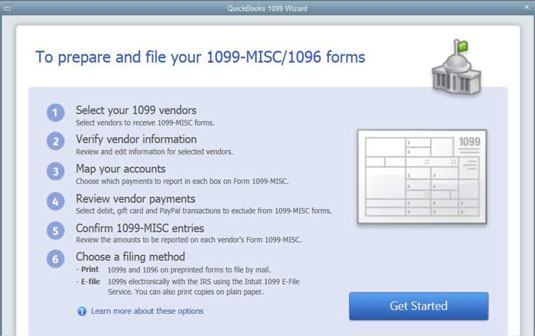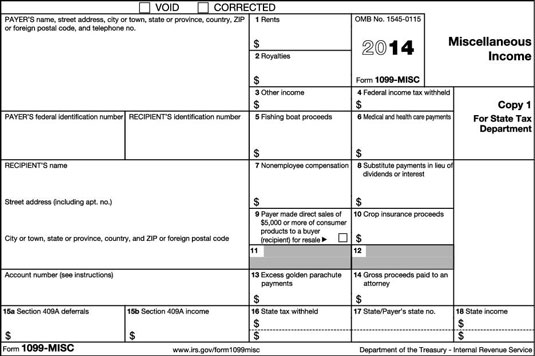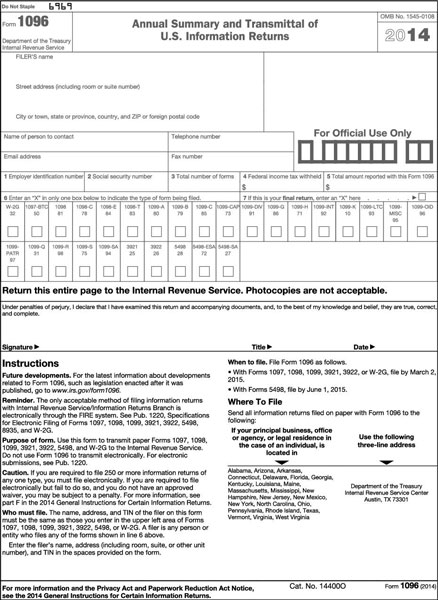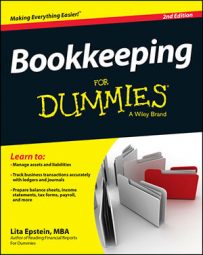For each contractor and vendor you pay over the course of the year, instead of preparing a W-2, you must complete Form 1099, Miscellaneous Income. The 1099 is an information form used to report income, interest payments, and dividend payments. To transmit the 1099 to the federal government, you use Form 1096, Annual Summary and Transmittal of U.S. Information Returns.
Your computerized accounting program can automatically generate 1099s and 1096s. If you’re using QuickBooks, you can find the 1099 Wizard in the Vendor drop-down menu under the item Print/E-file 1099s. The 1099 and 1096 Wizard then pops up to guide you through the rest of the process.

If you can’t generate these forms automatically from your computerized accounting system, or if you do your books manually, you can expect to work closely with your accountant on 1099s and 1096s. He or she can usually minimize the time it takes to prepare this paperwork by using professional tax preparation software programs.
There are actually 16 different types of 1099s. You use one form if you provide a medical savings account for your employees, and you use another if you distributed any money from an employee’s retirement account. You can access full instructions for the various 1099 forms online. As a small business owner, the one you’ll use the most is Form 1099-MISC4. It’s the one used to report independent contractor and vendor compensation.

The 1099-MISC contains 18 boxes, but depending on the type of payment you’re reporting, you may only need to fill out a few of them. The boxes are as follows:
Box 1: Rents. This box should contain the total of any rental payments made to the contractor or vendor for whom you’re filing the form.
Box 2: Royalties. This box should contain the total of any royalty payments made to a contractor.
Box 3: Other income. In this box, list any miscellaneous income that doesn’t fit in a designated box on the form.
Box 4: Federal income tax withheld. Most times, you don’t withhold federal income tax from a contractor or vendor, so this box remains empty. But sometimes a business does withhold federal income taxes for a contractor or a contractor.
Box 5: Fishing boat proceeds. Total any money paid to a fishing boat contractor and list it here.
Box 6: Medical and healthcare payments. It’s unlikely that you pay medical or healthcare benefits for a contractor or vendor, so this box will probably be left blank.
Box 7: Nonemployee compensation. In this box, record any nonemployee compensation that doesn’t fit in one of the other boxes.
Box 8: Substitute payments in lieu of dividends or interest.
Box 9: Check this box if you made direct sales of $5,000 or more of consumer products to a buyer for resale.
Box 10: Crop insurance proceeds. Indicate payments to farmers from crop insurance coverage by the insurance company.
Boxes 11 and 12: Blank.
Box 13: Excess golden parachute payments. This box should contain the total amount paid to an employee who has left the company.
Box 14: Gross proceeds paid to an attorney.
Boxes 15a: Section 409A deferrals, and 15b: Section 409A income. These boxes are for payments made as part of a nonqualified deferred compensation plan.
Boxes 16–18: These boxes are reserved for state governmental information.
You need to make three copies of your 1099s:
One to be sent to the vendor or contractor by January 31
One to be filed with the IRS by February 28, so that the income reported on a vendor’s or contractor’s individual tax return can be verified
One to keep in your company files
The 1099 form is for informational purposes and not attached to individual income tax forms filed with federal and state governments, so companies only need to provide one copy of the 1099 to its vendors and contractors.
A copy of the 1099 must be provided to contractors or vendors by January 31, but it does not need to be filed with the government until February 28. The IRS uses the information on this form to match income reported by these contractors and vendors on their individual tax returns. You’ll need to make three copies of this form — one for the vendor or contractor, one for the IRS, and one for your own files.
When filing 1099s with the government, you need a cover sheet. That cover sheet is a summary called Form 1096, Annual Summary and Transmittal of U.S. Information Returns. This form summarizes the information filed on 1099s, including the total number of 1099s filed, total federal income tax withheld, and total income reported.

Other forms that are included on this summary report aren’t likely to be filed by a small business, including the 1098 (student loan information), W-2G (gambling winnings), and 5498 (Coverdell ESA contribution).
If your company transmits the applicable information from Form 1096 electronically, you don’t actually need to use this form.

